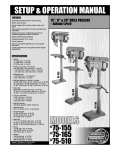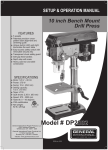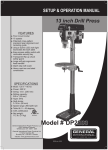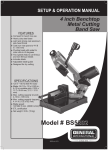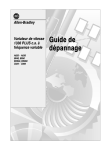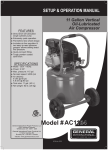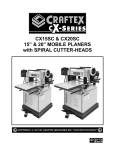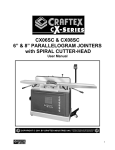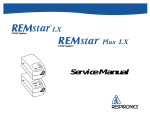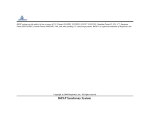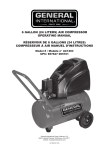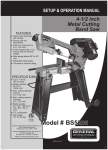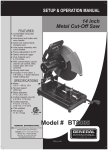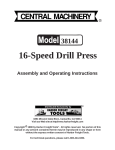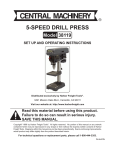Download Model # DP2001 - General International Products
Transcript
SETUP & OPERATION MANUAL 8 inch Bench Mount Drill Press FEATURES ●● 5 speeds ●● Patented precision crosspattern laser alignment and centering guide ●● Easy-access safety switch with removable security key ●● Transparent chuck safety guard ●● Soft-grip feed handles ●● Depth stop with scale ●● Heavy cast-iron and steel construction SPECIFICATIONS ●● Motor: 120 V ~ 60 Hz ●● Power: 250 W ●● Swing: 8 in. (208 mm) ●● Drilling capacity: 1/2 in. (13 mm) ●● Taper: JT33 ●● Spindle travel: 2 in. (50 mm) ●● Speed: 620 - 3100 rpm ●● Table tilt: 0 – 45 degrees ●● CSA certification ●● Net weight: 33 lb. (15 kg) Model # DP2001 DP2001 man v.141217 ENGLISH THANK YOU for choosing this General International machine. This tool has been carefully tested and inspected before shipment and if properly used and maintained, will provide you with years of reliable service. To ensure optimum performance and trouble-free operation, and to get the most from your investment, please take the time to read this manual before assembling, installing and operating the unit. The manual’s purpose is to familiarize you with the safe operation, basic function, and features of this tool as well as the set-up, maintenance and identification of its parts and components. This manual is not intended as a substitute for formal woodworking instruction, nor to offer the user instruction in the craft of woodworking. If you are not sure about the safety of performing a certain operation or procedure, do not proceed until you can confirm, from knowledgeable and qualified sources, that it is safe to do so. Once you’ve read through these instructions, keep this manual handy for future reference. GENERAL® INTERNATIONAL WARRANTY All component parts of General® International products are carefully inspected during all stages of production and each unit is thoroughly inspected upon completion of assembly. 2-YEAR LIMITED WARRANTY All products are warranted for a period of 2 years (24 months) from the date of purchase. General® International agrees to repair or replace any part or component which upon examination, proves to be defective in either workmanship or material to the original purchaser during this 2-year warranty period, subject to the “conditions and exceptions” as listed below. Repairs made without the written consent of General International will void the warranty. DISCLAIMER The information and specifications in this manual pertain to the unit as it was supplied from the factory at the time of printing. Because we are committed to making constant improvements, General International reserves the right to make changes to components, parts or features of this unit as deemed necessary, without prior notice and without obligation to install any such changes on previously delivered units. Reasonable care is taken at the factory to ensure that the specifications and information in this manual corresponds with that of the unit with which it was supplied. However, special orders and “after factory” modifications may render some or all information in this manual inapplicable to your machine. Further, as several generations of this model of dust collector and several versions of this manual may be in circulation, if you own an earlier or later version of this unit, this manual may not depict your machine exactly. If you have any doubts or questions contact your retailer or our support line with the model and serial number of your unit for clarification. TO FILE A CLAIM To file a claim under our Standard 2-year Limited Warranty, all defective parts, components or machinery must be returned freight or postage prepaid to General® International, or to a nearby distributor, repair center or other location designated by General® International. For further details call our service department at 1-888-949-1161. Along with the return of the product being claimed for warranty, a copy of the original proof of purchase and a “letter of claim” must be included (a warranty claim form can also be used and can be obtained, upon request, from General® International or an authorized distributor) clearly stating the model and serial number of the unit (if applicable) and including an explanation of the complaint or presumed defect in material or workmanship. CONDITIONS AND EXCEPTIONS This coverage is extended to the original purchaser only. Prior warranty registration is not required but documented proof of purchase, i.e. a copy of original sales invoice or receipt showing the date and location of the purchase as well as the purchase price paid, must be provided at the time of claim. 2 ENGLISH Warranty does not include failures, breakage or defects deemed after inspection by General® International to have been directly or indirectly caused by or resulting from; improper use, or lack of or improper maintenance, misuse or abuse, negligence, accidents, damage in handling or transport, or normal wear and tear of any generally considered consumable parts or components. Repairs made without the written consent of General® International will void all warranty. READ ALL INSTRUCTIONS BEFORE OPERATING SAVE THESE INSTRUCTIONS Before attempting to operate your new tool, please read these instructions thoroughly. You will need these instructions for the safety warnings, precautions, assembly, operation, maintenance procedures, parts list and diagrams. Keep your invoice with these instructions. Write the invoice number on the inside of front cover. Keep the instructions and invoice in a safe, dry place for future reference. THE WARNINGS, CAUTIONS AND INSTRUCTIONS discussed in this instruction manual cannot cover all possible conditions or situations that could occur. It must be understood by the operator that common sense and caution are factors which cannot be built into this product, but must be supplied by the operator. ! IMPORTANT SAFETY INSTRUCTIONS The purpose of safety symbols is to attract your attention to possible hazards. The safety symbols, and the explanations with them, deserve your careful attention and understanding. The safety warnings do not, by themselves, eliminate any danger. The instructions or warnings they give are not substitutes for proper accident prevention measures. DANGER! Indicates an imminently hazardous situation which, if not avoided, will result in serious injury or death. ! WARNING! Indicates an imminently hazardous situation which, if not avoided, could result in serious injury or death. ! CAUTION: Indicates an imminently risky situation which, if not avoided, could result in minor injuries or slight injury. It may also be used to notify the user to remain alert regarding unsafe practises which may cause property damage. ! 141217 3 ENGLISH WARNINGS AND CAUTIONS Be sure to read, understand and follow all safety warnings and instructions in the supplied operator’s manual. WORK AREA 1.KEEP CHILDREN AND BYSTANDERS AWAY. All children should be kept away from the work area. Don’t let them handle machines, tools or extension cords. Visitors can be a distraction and are difficult to protect from injury. 2.KEEP WORKING AREA CLEAN and be sure adequate lighting is available. Cluttered areas invite injuries. 3.MAKE WORKSHOP KID-PROOF with padlocks, master switches, or by removing starter keys. 4.AVOID DANGEROUS ENVIRONMENTS Don’t use power tools in damp or wet locations. Keep work area well lit. Do not expose power tools to rain. Do not use the tool in the presence of flammable liquids or gases. 5.STORE IDLE EQUIPMENT. Store equipment in a dry area to inhibit rust. Equipment also should be in a high location or locked up to keep out of reach of children. PERSONAL SAFETY 1.LEARN THE MACHINE’S APPLICATIONS AND LIMITATIONS, as well as the specific potential hazards particular to this machine. Follow available safety instructions and safety rules carefully. 2.DON’T OVERREACH. Keep proper footing and balance at all times. Do not reach over or across machines that are running. 3.STAY ALERT Watch what you are doing. Use common sense. Do not operate tool when you are tired. Do not operate while under medication or while using alcohol or other drugs. 4.AVOID DISTRACTIONS while operating this tool. 5.WEAR APPROPRIATE APPAREL Do not wear loose clothing, gloves, bracelets, necklaces,or jewellery while operating the tool. Wear face, eye, ear, respiratory and body protection devices, as indicated for the operation or environment. 6.ALWAYS WEAR SAFETY GLASSES Also use face or dust mask if cutting operation is dusty, and ear plugs during extended periods of operation. Everyday eyeglasses have only impact resistant lenses, they are NOT safety glasses. 7.WEAR BREATHING PROTECTION. Use of this tool can generate and/or disperse dust, which may cause serious and permanent respiratory or other injury. Many types of wood are naturally toxic, especially in dust form. Wear a clean dust mask if the work involves creating a lot of fine or coarse dust. Always use NIOSH/OSHA-approved respiratory protection appropriate for the dust exposure. Direct particles away from face and body. 8.WEAR HEARING PROTECTION, especially from repeated exposure. 9.GUARD AGAINST ELECTRIC SHOCK Prevent body contact with grounded surfaces. For example: pipes, radiators, ranges, refrigerator enclosures. When your body is grounded the risk of electric shock increases. When working wherever “live” electrical wires may be encountered, try to ascertain whether there is a danger of shock. Even so, DO NOT TOUCH ANY METAL PARTS OF THE TOOL while using it. Hold the tool only by the plastic grip to prevent electric shock if you contact a live wire. 10.ALWAYS DISCONNECT TOOL BEFORE SERVICING and when changing accessories such as belts, bits, blades, cutters. 11.KEEP GUARDS IN PLACE and in working order. If a guard must be removed for maintenance or cleaning, make sure it is properly attached before using the tool again. 4 WEAR YOUR FORESIGHT IS BETTER THAN NO SIGHT ENGLISH 12.ENSURE KEYS AND ADJUSTING WRENCHES ARE REMOVED before turning power on. Left attached, these parts can fly off a rotating part and result in personal injury. 13.MAKE SURE THAT SWITCH IS IN “OFF” POSITION before plugging in cord to reduce the risk of unintentional starts. 14.MAKE SURE TOOL IS PROPERLY GROUNDED. If tool is equipped with three-prong plug, it should be plugged into a three-pole electrical receptacle. Never remove the third prong. 15.NEVER STAND ON TOOL Serious injury could occur if the tool is tipped or if the cutting tool is unintentionally contacted. 16.KEEP HANDS WELL AWAY FROM ABRASIVE SURFACES and all moving parts. Do not clear chips and sawdust away with hands. Use a brush. 17.WHENEVER POSSIBLE USE A DUST COLLECTOR with shaving hood to minimize health hazards. 18.SECURE WORK. Use clamps or a vise to hold the work. It’s safer than using your hands and it frees both hands to operate the tool. 19.DISCONNNECT THE PLUG FROM POWER before making any adjustments. Changing attachments or accessories can be dangerous if the tool could accidentally start. TOOL SAFETY 1.MAKE SURE ALL DRILLING TOOLS are moving at operation speed before feeding. 2.DO NOT FEED THE MATERIAL TOO QUICKLY. The tool will perform better and be safer working at the rate for which it was designed. 3.NEVER LEAVE THE MACHINE WITH THE POWER ON. 4.DO NOT FORCE THE MACHINE. It will do the job better and be safer at a rate for which it was designed. Don’t force a small tool or attachment to do the work of a larger industrial tool. Don’t use a tool for a purpose for which it was not intended. 5.MAINTAIN TOOLS WITH CARE. Keep tools sharp and clean for better and safer performance. Follow instructions for lubricating and safe performance. Follow instructions for lubricating and changing accessories. Keep handles dry, clean and free from oil and grease. 6.DISCONNNECT THE PLUG FROM POWER BEFORE MAKING ANY ADJUSTMENTS. Changing attachments or accessories can be dangerous if the tool could accidentally start. 7.AVOID UNINTENTIONAL STARTING. Be sure the switch is in the OFF position before plugging in. Do not carry the tool with the power connected and your finger on the trigger. 8.KEEP GUARDS IN PLACE, in working order, in good adjustment and alignment. 9.DO NOT USE THE TOOL if it cannot be switched on or off. Have your tool repaired before using it. 10.CHECK FOR DAMAGED PARTS. Before using this tool, any part that is damaged should be carefully checked to determine that it will operate properly and perform its intended function. Check for alignment of moving parts, binding of moving parts, breakage of parts, mountings, and other conditions that may affect its operation. Inspect screws and tighten any ones that are loose. Any part that is damaged should be properly repaired or replaced by an authorized service center unless otherwise indicated elsewhere in the instruction manual. Have defective switches replaced by an authorized service center. Don’t use the tool if switch does not turn it on and off properly. 141217 5 ENGLISH 11.OBTAIN ADVICE from your supervisor, instructor or another qualified person if you are not thoroughly familiar with the operation of this machine. Knowledge is safety. 12.USE ONLY RECOMMENDED ACCESSORIES. Use of accessories NOT recommended by General International may result in a risk of injury. SERVICE 1.INSPECT AND MAINTAIN THE TOOL REGULARLY. Have it repaired only by an authorized repair technician. 2.MAINTAIN TOOLS WITH CARE. Keep tools sharp and clean for better and safer performance. Follow instructions for lubricating and safe performance. Follow instructions for lubricating and changing accessories. Keep handles dry, clean and free from oil and grease. 3.ENSURE THAT THE VENTILATION OPENINGS are kept clear of debris. 4.IF THE CORDSET IS DAMAGED HAVE IT REPAIRED only by an authorized service center. 5.SERVICE AND REPAIRS SHOULD BE MADE BY QUALIFIED REPAIR TECHNICIANS at an authorized repair center. Improperly repaired tools could cause serious shock or injury. 6.REPLACEMENT PARTS. When servicing, use only the manufacturer’s recommended replacement dentical replacement parts and accessories. 7.THE MANUFACTURER SHALL NOT BE LIABLE for any changes made to the tool, nor for any damage resulting from such changes. SAFETY RULES SPECIFIC TO THIS EQUIPMENT Because each shop situation is unique, no list of safety guidelines can ever be complete. The most important safety feature in any shop is the knowledge and good judgement of the user. Use common sense and always keep safety considerations, as they apply to your individual shop situation first and foremost in mind. If you have any doubts about the safety of an operation you are about to perform: STOP! Do not perform the operation until you have validated from qualified individuals if the operation is safe to perform and what is the safest method to perform it. WARNING! To avoid mistakes that could cause serious, permanent injury, do not plug the drill press in until the following steps have been completed: Assembly and alignment Learn the use and function of the on/off switch, feed handles, depth stop, belt tension adjustment, work table and work table tilt knob. Review and understanding of all safety instructions and operating procedures in this manual. Review of the maintenance methods for this tool. 1.READ THE WARNING LABELS ON THE TOOL. 2.AVOID UNINTENTIONAL STARTING. Be sure the switch is in the OFF position before plugging in. 3.ALWAYS CHECK AND MAKE SURE TO REMOVE ANY ADJUSTING KEYS OR WRENCHES before turning the tool on. Left attached, these parts can fly off a rotating part and result in personal injury. 4.DO NOT OPERATE THIS MACHINE UNTIL IT IS COMPLETELY ASSEMBLED and installed according to the instructions. A machine incorrectly assembled can cause serious injury. 6 ! ENGLISH NOTE: If any parts are damaged or missing, do not attempt to plug in the power cord and turn the switch on until the damaged or missing parts are obtained and are installed correctly. 5.SECURE THE MACHINE TO A SUPPORTING SURFACE. Vibration can cause the machine to slide, walk, or tip over. To avoid injury from unexpected movement, make sure the tool is on a firm, level surface, properly secured to prevent rocking. Make sure there is adequate space for operations. 6.STABILITY OF THE DRILL PRESS The drill press may show a tendency to tilt or move during use. If so, bolt it to the bench top or to a piece of 3/4" plywood large enough to stabilize it. 7.NEVER CLIMB OR STAND ON THE TOOL. It could break or pull the entire drill press down on you. Serious injury could occur if the tool tips. Do not store anything above or near the tool where anyone might stand on the tool to reach them. 8.SECURELY LOCK THE HEAD AND TABLE SUPPORT BRACKET TO THE COLUMN, and the table to the table support bracket before operating the drill press. Never move either the head or table support bracket while the tool is running. 9.ALWAYS CHECK AND MAKE SURE TO REMOVE THE CHUCK KEY, any adjusting keys or wrenches before turning the tool on. Left attached, these parts can fly off a rotating part and result in personal injury. 10.BEFORE STARTING THE OPERATION, CHECK FOR MISALIGNMENT IN THE CHUCK. Jog (turn on, then immediately off) the motor switch to make sure the drill bit or other cutting tool does not wobble or cause vibration. 11.NEVER TURN THE MACHINE ON BEFORE clearing the table/work area of all objects (tools, scraps of wood, etc.). Flying debris is dangerous. 12.USE EXTRA SUPPORTS (tables, saw horses, blocks, etc.) for any workpiece large enough to tip when not held down to the work table. 13.DO NOT LEAVE THE WORK AREA UNTIL ALL MOVING PARTS HAVE STOPPED. Shut off the power to master switches. Childproof the workshop! NOTE: If any parts are damaged or missing, do not attempt to plug in the power cord and turn the switch on until the damaged or missing parts are obtained and are installed correctly. 14.BEFORE STARTING, be certain the motor, table, attachments and adjustment knobs are secured. 15.CHECK FOR DAMAGED PARTS. Before using this tool, any part that is damaged should be carefully checked to determine that it will operate properly and perform its intended function. Check for misalignment of moving parts, binding of moving parts, breakage of parts, mountings and other conditions that may affect its operation. Inspect screws and tighten any that are loose. Any part that is damaged should be properly repaired or replaced by an authorized service center unless otherwise indicated elsewhere in the instruction manual. Have defective switches replaced by an authorized service center. Don’t use the tool if switch does not turn it on and off properly. 16.OBTAIN ADVICE from your supervisor, instructor, or another qualified person if you are not thoroughly familiar with the operation of this machine. Knowledge is safety. 17.NEVER TURN THE MACHINE ON with the workpiece contacting the bit. Workpiece may be thrown and cause injury or damage. 141217 7 ENGLISH 18.PREVENT THE WORKPIECE from contacting the bit before starting the tool. Loss of control of the workpiece is dangerous. 19.NEVER TURN THE MACHINE ON before clearing the table/work area of all objects (tools, scraps of wood, etc.). Flying debris is dangerous. 20.DISCONNNECT THE PLUG FROM POWER BEFORE MAKING ANY ADJUSTMENTS. Changing attachments, making bit changes, adjustments or repairs or accessories can be dangerous if the tool could accidentally start. Turn off and unplug the drill press before moving it. 21.TURN THE MACHINE OFF, disconnect the machine from the power source, when not in operation and before leaving the machine. Clean the table/work area before leaving the machine. 22.DO NOT LEAVE THE WORK AREA UNTIL ALL MOVING PARTS HAVE STOPPED. Shut off the power to master switches. Childproof the workshop! 23.TO FREE ANY JAMMED MATERIAL, TURN THE SWITCH OFF. Unplug the tool. Wait for all moving parts to stop before removing the jammed material. 24.NEVER WORK FREE HAND (hand-holding the workpiece rather than supporting it on the table), except when polishing. 25.PREVENT THE WORKPIECE FROM BEING PULLED OUT OF YOUR HANDS, SPINNING ON THE TABLE, shattering the tool, or being thrown. Always support your work so it won’t shift or bind on the tool. 26.ALWAYS POSITION THE WORKPIECE AND BACKUP MATERIAL (used beneath the workpiece) to contact the left side of the column. Whenever possible, position the workpiece to contact the left side of the column — if it is short or the table is tilted, clamp it solidly to the table. 27.CLAMP OR BRACE WORKPIECE AGAINST COLUMN to prevent rotation. 28.SUPPORT THE WORKPIECE FIRMLY WITH A CLAMP, vise, or work table when drilling. Hold the workpiece firmly. Loss of control of the workpiece can result in injury. 29.WHEN USING A DRILL PRESS VISE, always fasten it securely to the table. 30.PROPERLY SUPPORT LONG OR WIDE WORKPIECES. If a workpiece overhangs the table so that it could fall or tip if not held, clamp it to the table or provide auxiliary support(s). Loss of control of the workpiece is dangerous. 31.SUPPORT ROUND WORK PROPERLY Use V blocks to prevent it from rolling. 32.USE THE RECOMMENDED SPINDLE SPEED for the specific operation and workpiece material — check the label inside the pulley cover for drilling information 33.KEEP PULLEY COVER CLOSED when not making belt adjustments. 34.TO AVOID INJURY FROM THROWN WORK OR TOOL CONTACT, do not perform layout, assembly, or setup work on the table while the chuck is rotating. 35.USE ONLY ACCESSORIES DESIGNED FOR THIS DRILL PRESS to avoid serious injury from thrown, broken parts or work pieces. 36.WHEN CUTTING LARGE DIAMETER HOLES, CLAMP THE WORKPIECE FIRMLY TO THE TABLE. Otherwise the cutter may grab and spin at high speed. Use only one piece, cup-type hole cutters. DO NOT use fly cutters or multi-part hole cutters as they may come apart or become unbalanced in use. 8 ENGLISH 37.ACCESSORIES MUST BE RATED FOR AT LEAST THE SPINDLE SPEED SETTING OF THE DRILL PRESS. This drill press has 5 spindle speeds. Check spindle speed setting of the drill press based on pulley speed chart located inside the pulley housing. Ensure accessories used have a higher speed rating than the current spindle speed setting of the drill press. Accessories running faster than rated speed can fly apart and cause injury. 38.DO NOT INSTALL OR USE DRILL BITS THAT EXCEED 7" (18 cm) in length or extend 6" (15 cm) below the chuck jaws. They can suddenly bend outward or break. 39.DO NOT USE WIRE WHEELS, ROUTER BITS, SHAPER CUTTERS, CIRCLE (FLY) CUTTERS, OR ROTARY PLANERS on this drill press. 40.AVOID AWKWARD OPERATIONS AND HAND POSITIONS. A sudden slip could cause a hand to move into the bit. 41.NEVER PERFORM LAYOUT, ASSEMBLY, OR SET-UP WORK ON THE TABLE /work area when the machine is running. A sudden slip could cause a hand or hair to move into the spinning bit or chuck. Severe injury can result. 42.DO NOT GET DISTRACTED AND ALWAYS CONCENTRATE ON WHAT YOU ARE DOING. Use common sense. Never operate the machine when you are tired, sick, or under the influence of alcohol, or other drugs. 43.TURN THE MACHINE OFF, disconnect the machine from the power source and clean the table / work area before leaving the machine. 44.LOCK THE SWITCH IN THE “OFF” POSITION TO PREVENT UNAUTHORIZED USE. Someone else might accidentally start the machine and cause injury to themselves. 45.KEEP THESE INSTRUCTIONS. Refer to them frequently and use them to instruct other users. If you lend someone this unit, also lend them the instructions. 46.FAILURE TO FOLLOW OPERATING INSTRUCTIONS AND SAFETY PRECAUTIONS IN THIS INSTRUCTION MANUAL CAN RESULT IN SERIOUS INJURY. Read the manual before starting or operating this unit. 47.KEEP THESE INSTRUCTIONS. Refer to them frequently and use them to instruct other users. If you loan someone this unit, also loan them the instructions. HEALTH NOTICE: Some dust created by power sanding, sawing, grinding, drilling, and other construction activities contain chemicals known to cause cancer, birth defects or other reproductive harm. Some examples of these chemicals are: ─Lead from lead-based paints ─Crystalline silica from bricks and cement and other masonry products ─Arsenic and chromium from chemically-treated lumber Your risk from these exposures varies, depending on how often you do this type of work. To reduce your exposure to these chemicals, work in a well ventilated area, and work with approved safety equipment, such as those dust masks that are specially designed to filter out microscopic particles. ! ELECTRICAL WARNINGS AND CAUTIONS 1.BEFORE CONNECTING THE MACHINE to the power source, verify that the voltage of your power supply corresponds with the voltage specified on the motor I.D. nameplate. A power source with greater voltage than needed can result in serious injury to the user as well as damage to the machine. If in doubt, contact a qualified electrician before connecting to the power source. 141217 9 ENGLISH 2.MAKE SURE YOUR FINGERS do not contact the terminals of the power cord plug when plugging in or unplugging the saw. 3.GROUNDED TOOLS MUST BE PLUGGED INTO AN OUTLET THAT ITSELF IS PROPERLY INSTALLED AND GROUNDED. Grounding provides a low-resistance path to carry electricity to ground away from the operator, should the tool malfunction electrically. 4.DO NOT ABUSE THE CORD. Never carry your tool by the cord or pull on the cord to unplug it. Protect the cord from potential sources of damage: heat, oil & solvents, sharp edges, or moving parts. Replace damaged cords immediately. 5.WHEN WORKING OUTDOORS, USE AN OUTDOOR-RATED EXTENSION CORD. An extension cord rated for outdoor use must be marked “W-A” or “W”. 6.THIS TOOL IS FOR INDOOR USE ONLY. Do not expose electrical power tools to moisture. Rain or wet conditions can cause water to enter the tool and lead to electric shock. 7.FOLLOW ALL LOCALLY APPLICABLE WIRING CODES and recommended electrical connections to prevent shock or electrocution. GROUNDING INSTRUCTIONS In the event of an electrical malfunction or short circuit, grounding reduces the risk of electric shock. The motor of this machine is wired for 120 V single phase operation and is equipped with a 3-conductor cord and a 3-prong grounding plug to fit a grounded type receptacle B. Do not remove the 3rd prong (grounding pin) to make it fit into an old 2-hole wall socket or extension cord. If an adaptor plug is used C, it must be attached to the metal screw of the receptacle. NOTE: The use of an adaptor plug is illegal in some areas, including Canada. Check your local codes. If you have any doubts or if the supplied plug does not correspond to your electrical outlet, consult a qualified electrician before proceeding. EXTENSION CORDS If you find it necessary to use an extension cord with your machine, use only 3-wire extension cords that have 3-prong grounding plug and a matching 3-pole receptacle that accepts the tool’s plug. Repair or replace a damaged extension cord or plug immediately. Make sure the cord rating is suitable for the amperage listed on the motor I.D. plate. An undersized cord will cause a drop in line voltage resulting in loss of power and overheating. The accompanying chart shows the correct size extension cord to be used based on cord length and motor I.D. plate amp rating. Total Extension Cord Length Amp Rating Feet Meters Feet Meters Feet Meters Feet Meters 25 8 50 15 100 30 125 40 3-10 amp 18 ga. 16 ga. 14 ga. 14 ga. 10.1 - 12 amp 16 ga. 16 ga. 14 ga. 14 ga. 12.1 - 16 amp 14 ga. 12 ga. Not Recommended Use only UL or CSA approved extension cords WARNING! Do not allow familiarity with your tool to make your careless. Remember that a careless fraction of a second is sufficient to inflict severe injury. IMPORTANT: The warnings, cautions and instructions detailed in this manual cannot cover all possible conditions and situations that occur. It must be understood by the operator that common sense and caution are factors that cannot be built into this product, but must be supplied by the operator. 10 ! ENGLISH LASER SAFETY This tool is equipped with a patented precision cross-pattern laser alignment and centering guide. 1.DO NOT STARE DIRECTLY AT THE LASER BEAM. DANGER! Eye damage may occur if you deliberately stare into the beam. ! 2.THE LASER LIGHT BEAM used in this system is Class II with maximum 1 mW and 660 nm wavelengths. AVOID DIRECT EYE EXPOSURE. 3.THE LASER MUST BE USED AND MAINTAINED IN ACCORDANCE WITH THE MANUFACTURER’S INSTRUCTIONS: • Never aim the beam at any person or an object other than the workpiece. • Do not project the laser beam into the eyes of others. • Always ensure the laser beam is aimed at a workpiece without reflective surfaces as the laser beam could be reflected into your eyes or the eyes of others. UNPACKING WARNING! Do not attempt to assemble the drill press, plug in the power cord or turn on the switch if any parts are damaged or missing. Failure to heed this warning could result in serious personal injury. ! CONTENTS Separate all parts from the packing materials and check carefully against fig. 2 and the list below. NOTE: Make certain all parts are accounted for before discarding any packing material. Some items below may be packed already assembled to each other. A Table support bracket B Support lock handle C Column D Base E Column support collar F M8 x 20 hex head screw (3 pcs.) G Table bevel lock screw H Table I Head assembly J Chuck guard K 1/2" Chuck L Chuck key M Feed handles (3 pcs.) 141217 11 ENGLISH FUNCTIONAL DESCRIPTION GETTING TO KNOW YOUR DRILL PRESS WARNING! To avoid injury from accidental start, turn the switch off and remove the plug from the power source outlet before making any adjustments. ! A Table support bracket B Support lock handle C Column D Base E Column support collar G Table bevel lock screw H Table J Chuck safety guard K 1/2” chuck M Feed handle N On / Off switch O Switch lock-out key P Quill return spring Q Depth stop rod & nuts R Motor pivot S Laser switch T Motor U Belt & pulley cover V Depth scale and indicator W Head lock set-screws X Cover handle Y Belt tension lock ASSEMBLY PROCEDURE WARNING! For your own safety, never connect the plug to the power source outlet or insert the switch insert key until all the assembly steps are complete and you have read and understood the entire owner's manual. 1.Install 3 pcs. M8 x 20 bolts (F, fig 2), threading them into the base (D, fig 2 & 3) through the column support collar (E, fig 2 & 3) and tighten them with a wrench. 2.Slide the table support bracket (A, fig 2 & 3) onto the column. 3.Install the support lock handle (B, fig 2 & 3) from the left side into the table support, align the table with the base and and tighten the support lock handle by hand. 4.Lift the head assembly (I, fig.1) above and slide it onto the top of the column. NOTE: The head assembly is heavy and you may require assistance from a second person. 5.Align the head assembly with the table and base. 6.Using a 4 mm hex (Allen) key, fasten the head assembly in place by tightening the head lock set screws (W, fig 3) in the right side of the head casting. 7.Screw the three feed handles (M, fig 2 & 3) into the the threaded holes in the hub. Instead of using the knobs for leverage and possibly stripping them, use a wrench on the flats at the threaded ends of the handles to tighten. 12 ! ENGLISH 8.Clean out the tapered hole in the chuck (K, fig 2 & 3), removing any grease, anti-rust coating or dirt you find. 9.Clean grease, coating and dirt from the tapered spindle tip with a clean cloth. 10.Open the chuck's jaws as far as they will go so they are fully retracted into the chuck. 11.Push the chuck up on the spindle as far as possible. Lightly tap the lower end of the chuck with a piece of wood to ensure the chuck fits tightly on the spindle. 12.Install an M5 x 12 pan head screw from the inside of the pulley cover through the hole and attach the knob (X, fig 3) to the outside. LASER BATTERIES 1.Locate the laser switch (S, fig 3) on the left side of the head assembly. 2.Press the tab located below the laser switch (fig 4) and raise the cover. 3.Insert 2 "AA" batteries, oriented in the directions indicated. 4.Close the switch cover. CAUTION: Remove the laser light batteries when the tool is to be stored without use for a few days or more. If left in position, the batteries might leak and damage the laser light assembly. Damage due to leaking batteries is not covered under the warranty. ! OPERATING INSTRUCTIONS WARNING! Before using this machine, the operator should carefully read over this operation manual and acquaint himself with the construction, controls and drive system of the drill press. ! SET THE SPEED 1.Open the belt & pulley cover (U, fig 2 & 3) and choose the best speed for the drilling operation planned and install DP2001 belt spindle labelthe belt in the correct 100 x 40 that mm R=2 position on the pulleys to produce speed. rpm: 620 tr/min spindle broche rpm: 1720 tr/min spindle broche motor moteur motor moteur rpm: 1100 tr/min spindle broche rpm: 2340 tr/min spindle broche motor moteur motor moteur rpm: 3100 tr/min spindle broche motor moteur WARNING! Be sure the drill press is turned off and unplugged when the belt & pulley cover is open and you have your hands in that area. ! 2.To move the belt, loosen the belt tension lock knob (Y, fig 3) on the right side of the head assembly, and let the motor pivot forward so that it reduces the distance between the drive (motor) pulley and the spindle pulley. 3.Place the belt on the two pulleys according to the needed spindle speed. 4.Re-tension the belt when it is set in position by pivoting the motor away from the spindle (front) end of the drill press head and re-tighten the belt tension lock knob. 5.Close the cover 141217 13 ENGLISH DRILL BIT 6.Insert the drill bit into the chuck (K, fig 3) far enough to obtain maximum grip from the chuck jaws. Make sure the drill bit is centered in the chuck. 7.Insert the chuck key (L, fig 2) and turn it clockwise to tighten (and counter-clockwise to loosen) the drill bit. Tighten the chuck sufficiently to prevent the bit slipping in the jaws during drilling. As a test, turn the drill press on and immediately off to check if the drill bit wobbles. TABLE ADJUSTMENT 8.To position the table (H, fig 2) vertically, loosen the support lock handle (B, fig 2) and raise or lower the table to the desired position. Re-tighten the support lock handle. 9.Line up the drill bit with the table center hole when through-boring to avoid damage to the table. 10.To tilt the table, loosen the table bevel lock screw (G, fig 2) under the table, tilt the table to the desired angle (you can use the bevel scale on the support as a rough gauge) and re-tighten the table bevel lock screw. NOTE: It is a good idea to always check that the angle is correct with a protactor or a combination square. DEPTH CONTROL 11.The drilling depth may be controlled by watching the indicator and depth scale (V fig 3), on the left side of the drill press head, or it can be regulated quite precisely by setting the depth stop nuts on the depth stop rod (Q, fig 3). 12.Check that the chuck key is not in the chuck and that the drill bit is not contacting the workpiece. Check that the workpiece is properly anchored on the table. Be sure that all the safety rules at the front of this manual are followed. LASER 13.Place a work piece on the table. 14.Turn the laser switch to the on (I) position. 15.Lower the drill bit to meet the work piece. The two laser lines should cross where the drill meets the work piece. 16.If the laser needs to be adjusted: ●● Using a hex wrench, turn the laser adjustment hex screws (3) counterclockwise. ●● Move the laser light housing until the two lines intersect where the drill meets the work piece. DO NOT stare directly at the laser lines. ●● Re-tighten the adjustment hex screws . DRILLING 17.Turn the switch on. 18.Use the feed handles to push the drill bit slowly into the material. Particularly in wood drilling, ease up on the pressure when nearing the point where the drill bit is about to emerge on the other side of the workpiece. 19.After drilling a hole, do not release the feed handle but restrain it lightly, allowing the spring to raise spindle sleeve gently to its original position. 20.Turn off the drill press. 21.Switch off the laser. WARNING! After switching off, never leave the machine unattended until it has come to a complete stop. ! WARNING! In case of any trouble or abnormal noise arising during this operation, stop the motor at once, unplug the machine from the power source and find out the cause. Do not resume until the problem has been solved. ! 14 WARNING! For your own safety, turn the switch off and remove the plug from the power source outlet before adjusting, maintaining or lubricating your drill press. ! WARNING! To avoid electrocution or fire, any repairs to electrical systems should be done by an authorized repair center. ! ENGLISH MAINTENANCE GENERAL 1.If power cord is worn, cut or damaged in any way, have it replaced immediately. 2.After use, blow out or vacuum sawdust and metal chips that may have accumulated in and on the motor, the belt and pulley housing, and the table. 3.Ball bearings are packed with grease at the factory. They require no further lubrication. The ball bearings in the spindle and the V-belt pulley assembly are greased and permanently sealed. 4.Periodically pull down and lubricate the grooves in the spindle and the rack (teeth of the quill), usually about every three months. 5.Occasionally apply a light coat of paste wax to the column and table to help keep these surfaces clean and rust-free. 6.Lubricate the table bracket and locking knobs if they become difficult to use. 7.Cut off the power supply when not in use. NOTE: SERVICE AND REPAIRS should be made by qualified repair technicians at an authorized repair center. Improperly repaired tools could cause serious shock or injury. NOTE: REPLACEMENT PARTS. When servicing, use only the manufacturer’s recommended replacement dentical replacement parts and accessories. 141217 15 ENGLISH PARTS LIST POS. PART NO. DESCRIPTION QTY. POS. PART NO. DESCRIPTION QTY. 1 13101001G Base 1 39 GB894.1-86 Retaining ring 22 1 2 13101002B Column support 1 40 13102022 Pulley insert 1 3 GB21-76 Screw, hex hd. M8 x 20 3 41 GB276 Bearing, ball 6203 2 4 13101003A Column tube 1 42 13302023A Spacer 1 5 13101004A Table support 1 43 GB894.1-86 Retaining ring 17 1 6 16101013A Table clamp 1 44 13106002A Pointer 1 7 13101014G Table 1 45 13103005 Depth stop rod 1 8 GB5781-86 Screw hex hd. M12 x 25 1 46 GB6172-86 Nut, hex M10 4 9 DT/SA027 Knob 3 47 GB78-85 Screw, hex. soc. set M8 x 8 1 10 13104005C Feed handle rod 3 48 13104008 Cap, spring 1 11 13104002C Shaft pinion 1 49 13104009 Spring, tension 1 12 GB/T6172.1 Hex nut M8 1 50 GB862.1-87 Star washer 5 2 13 13102021 Socket set screw 1 51 GB/T93 Spring washer 5 2 14 GB80-85 Hex socket set screw M8 x 8 2 52 GB818-85 Screw, pan hd. M5 x 6 2 15 13102005B Motor adjust knob 1 53 13102008C Box, switch w/depth scale 1 16 13102004 Motor stop spring 1 54 GB818-85 Screw, pan hd. M5 x 14 2 17 13102002 Motor stop 1 55 13102009B Switch plate 1 18 131A02026A Laser localizer 2 56 GB848-85 Screw, pan hd. ST4.2 x 9.5 2 19 GB879-86 Roll pin φ4 x 18 1 57 HY18-2P Switch 1 20 YYG7124C-T Motor 1 58 13303006-1 Gasket, quill 1 21 13105005C Pulley, motor 1 59 GB276-89 Bearing, ball 6201 2 22 GB80-85 Hex socket set screw M8 x 10 2 60 13103002C Tube, quill 1 23 GB5781-86 Hex screw M8 x 25 2 61 GB97.2-89 Washer 6 1 24 GB97.2-85 Washer 8 2 62 13108002 Eye shield 1 25 DNI985-87 Lock nut M8 2 63 GB6170-86 Hex nut M6 1 26 13102001H Head 1 64 GB894.1-86 Retaining ring 11 1 27 20105012 Bushing, rubber 2 65 13103001B Shaft, spindle 1 28 13105009 Washer, foam 4 66 13103006M Chuck 1 29 13105000G Guard 1 67 13103006-2 Key, chuck 1 30 13105007 V-belt, K26 1 68 GB5356-85 Wrench, hex "L" S3 1 31 GB97.2-89 Washer 6 4 69 GB5356-85 Wrench, hex "L" S4 1 32 GB818-85 Pan head screw M6 x 12 4 70 DLCKEE2S08 Cord & plug 1 33 GB/T818 Screw, pan M5 x 10 1 71 13208001 Battery compartment 1 34 GB/T80 Hex.soc screw M6 x 6 2 72 GB818-85 Screw, pan M4 x 10 2 35 13205010 Knob 1 73 131A05004 Battery 2 36 GB818-85 Screw, pan hd. M5 x 10 2 74 13208001-1A Lid, cell box 1 37 16102014A Clamp, cord 2 75 KCD7-101 Switch, laser 1 38 13105006F Pulley, spindle 1 76 GB6170-86 Hex nut M5 2 16 ENGLISH SCHEMATIC DRAWING 141217 17 MANUEL D’INSTRUCTIONS ET D’ASSEMBLAGE Perceuse à colonne de 8 po pour établi CARACTÉRISTIQUES ●● 5 Vitesses ●● Laser de précision avec guide de centrage au design cruciforme breveté ●● Clé de sécurité amovible facilement accessible ●● Garde de sécurité du mandrin transparent ●● Grande poignées d’alimentation ergonomique ●● Guide d’arrêt avec gradation ●● Construction robuste de fonte et d’acier SPÉCIFICATIONS ●● Moteur : 120 V ~ 60 Hz ●● Puissance : 250 W ●● Diamètre de perçage : 8 po (208 mm) ●● Capacité de perçage : 1/2 po (13 mm) ●● Fuselage : JT33 ●● Course de l’axe : 2 po (50 mm) ●● Plage de vitesse : 620 à 3 100 tr/min ●● Table pivotante de 0 à 45 degrés ●● Certification CSA ●● Poids net : 33 lb (15 kg) Modèle # DP2001 DP2001 man v.141217 FRANÇAIS NOUS VOUS REMERCIONS d’avoir choisi une machine de General International. Cette outil a été soigneusement testée et inspectée avant de vous être expédiée, et moyennant une utilisation et un entretien adéquats, elle vous procurera un service fiable pendant de nombreuses années. Afin d’obtenir un rendement optimal et une utilisation sans problème, et d’optimiser votre investissement, veuillez prendre le temps de lire ce manuel avant d’assembler, d’installer et d’utiliser l’unité. Ce manuel vise à vous familiariser avec l’utilisation sécuritaire, les fonctions élémentaires et les caractéristiques de cette scie ainsi qu’avec le réglage, l’entretien et l’identification de ses parties et composantes. Il n’est pas conçu pour remplacer un enseignement théorique sur le travail ni pour offrir à l’utilisateur une formation en la matière. En cas de doute concernant la sécurité d’une opération ou d’une procédure, demandez l’aide d’une personne qualifiée avant d’entamer le travail. Une fois que vous avez lu ces instructions, conservez ce manuel aux fins de consultation ultérieure. GARANTIE DE GENERAL® INTERNATIONAL Toutes les composantes des machines de General® International sont soigneusement inspectées durant chacune des étapes de production, et chaque unité est inspectée en profondeur une fois l’assemblage terminé. GARANTIE STANDARD LIMITÉE DE 2 ANS En raison de son engagement envers la qualité et la satisfaction du consommateur, General® International accepte de réparer ou de remplacer toute pièce qui, suite à l’examen, se révèle défectueuse quant aumatériel et au fini d’exécution pour une période de 2 ans (24 mois) suivant la date d’achat. Pour se prévaloir de la garantie, l’acheteur doit retourner toutes les pièces défectueuses port payé à General® International. Les réparations effectuées sans le consentement écrit de General® International annuleront la garantie. CLAUSE DE NON-RESPONSABILITÉ L’information et les caractéristiques présentées dans ce manuel se rapportent à la machine telle qu’elle est sortie de l’usine au moment de mettre sous presse. En raison de son souci d’amélioration constante, General International se réserve le droit de modifier des composantes, des pièces ou des caractéristiques de la machine si cela est jugé nécessaire, sans préavis et sans obligation d’effectuer ces modifications sur les machines déjà vendues. On prend soin de s’assurer à l’usine que les caractéristiques et l’information présentées dans ce manuel correspondent à la machine avec laquelle il est fourni. Toutefois, en raison de commandes spéciales et de modifications réalisées “hors de l’usine,” une partie ou la totalité de l’information contenue dans ce manuel peut ne pas s’appliquer à votre machine. De plus, comme il se peut que plusieurs générations de ce modèle de scie. et plusieurs versions de ce manuel soient en circulation, il est possible que ce manuel ne décrive pas exactement votre machine si vous possédez une version antérieure ou ultérieure. Si vous avez des doutes ou des questions, veuillez communiquer avec votre détaillant ou notre ligne de soutien technique et mentionner le numéro de modèle et de série de votre machine afin d’obtenir des éclaircissements. DEMANDE DE RÉCLAMATION Pour présenter une demande de réclamation en vertu de notre Garantie Standard Limitée de 2 ans, ou en vertu de notre Garantie Limitée à Vie, toute pièce, composante ou machinerie défectueuse doit être retournée, port payé, à General® International, ou encore à un distributeur, un centre de réparation ou tout autre emplacement situé près de chez vous et désigné par General® International. Pour plus d’informations ou si vous avez besoin d’aide pour remplir une demande de réclamation, contactez notre département de service au 1-888-949-1161. Une copie de la preuve d’achat originale ainsi qu’une lettre (un formulaire 20 FRANÇAIS de réclamation de garantie peut vous être fourni sur demande par General® International ou par un distributeur agréé) spécifiant clairement le modèle et le numéro de série de l’unité (si applicable), et faisant état de la plainte ou du défaut présumé, doivent être jointes au produit retourné. CONDITIONS ET EXCEPTIONS Cette couverture ne s’applique qu’au premier acheteur. Un enregistrement préalable de la arantie n’est pas requis. Par contre, une preuve d’achat – soit une copie du coupon de caisse ou du reçu original, sur lequel figurent la date et le lieu d’achat ainsi que le prix payé – doit être fournie lors de la réclamation. La Garantie ne couvre pas les défaillances, bris ou défauts qui, après examen par General® International, sont considérés comme étant directement ou indirectement causés par ou résultant de: une utilisation incorrecte, un entretien inadéquat ou l’absence d’entretien, un usage inapproprié ou abusif, la négligence, un accident, des dommages survenus durant la manutention ou le transport, ou encore l’usure normale ou la détérioration des pièces et composantes considérées, de façon générale, comme étant des consommables. Les réparations effectuées sans le consentement écrit de General® International annuleront toute garantie. LISEZ TOUTES LES INSTRUCTIONS AVANT L’UTILISATION CONSERVEZ CES INSTRUCTIONS Avant d’essayer de faire fonctionner votre nouvel outil, veuillez lire les instructions au complet. Vous aurez besoin de ces instructions pour les avertissements de sécurité, les précautions, l’assemblage, le fonctionnement, les procédures d’entretien, la liste des pièces et les schémas des pièces. Gardez votre facture avec ces instructions. Écrivez votre numéro de facture à l’intérieur de la page couverture. Gardez les instructions ainsi que la facture dans un endroit sûr et sec pour référence future. LES AVERTISSEMENTS, LES PRÉCAUTIONS ET LES instructions discutés dans ce manuel ne peuvent pas couvrir toutes les conditions et les situations qui pourraient survenir. L’utilisateur se doit de comprendre que le bon sens ainsi que la prudence sont des facteurs qui ne peuvent être incorporés dans ce produit, mais peuvent être fournis par l’utilisateur lui-même. ! REGLES DE SÉCURITÉ ET DIRECTIVES L’objectif des symboles de sécurité est d’attirer votre attention sur les risques potentiels. Les symboles de sécurité, ainsi que les explications les accompagnant, nécessitent votre attention et votre compréhension. Les avertissements de sécurité n’éliminent pas d’eux-mêmes tous les dangers. Les instructions ou les avertissements qu’ils donnent ne sont pas un remplacement aux mesures de prévention d’accident appropriées. DANGER! Indique une situation à risque imminent, laquelle si elle n’est pas évitée, causera de sérieuses blessures ou la mort. ! AVERTISSEMENT! Indique une situation à risque imminent, laquelle si elle n’est pas évitée, pourrait causer de sérieuses blessures ou la mort. ! ATTENTION: Indique une situation à risque imminent, laquelle si elle n’est pas évitée, peut causer des blessures mineures ou des blessures légères. Il peut aussi être utile de demeurer alerte au sujet des pratiques non sécuritaires qui pourraient causer des dommages à la propriété. ! 141217 21 FRANÇAIS AVERTISSEMENTS ET PRÉCAUTIONS Assurez-vous de lire, comprendre et suivre tous les avertissements et consignes de sécurité dans le manuel de l'opérateur. ZONE DE TRAVAIL 1.TENEZ LES ENFANTS ET AUTRES PERSONNES ÉLOIGNÉS Tous les enfants doivent être tenus à l'écart de la zone de travail. Ne les laissez pas utiliser des machines, des outils ou des rallonges électrique. Les visiteurs peuvent être une distraction et sont difficiles à protéger contre les blessures. 2.GARDER LE LIEU DE TRAVAIL PROPRE et assurez-vous d'un éclairage adéquat est disponible. Les endroits encombrés peuvent crée des blessures. 3.METTRE L'ATELIER L’ÉPREUVE DES ENFANTS avec des cadenas, avec les interrupteurs principaux ou en retirant les clés de démarrage. 4.ÉVITEZ LES ENVIRONNEMENTS DANGEREUX Ne pas utiliser d'outils électriques dans des endroits humides ou mouillés. Garder la zone de travail bien éclairé. Ne pas exposer les outils électriques à la pluie. Ne pas utiliser l'outil en présence de liquides ou gaz inflammables. 5.ENTREPOSAGE DES ÉQUIPEMENTS Entreposer vos équipements dans un endroit sec pour empêcher la rouille. Les équipements devraient aussi être entreposés dans un endroit verrouillé ou garder hors de portée des enfants. SÉCURITÉ PERSONNELLE 1.APPRENDRE LES APPLICATIONS ET LES LIMITES DE LA MACHINE ainsi que les risques spécifiques à cette machine. Suivez les instructions de sécurité disponibles et les règles de sécurité attentivement. 2.NE PAS TROP SE PENCHER Garder une position correcte en tout temps. 3.DEMEURER ALERTE Regardez ce que vous faites. Utilisez votre bon sens. Ne pas utiliser l'outil lorsque vous êtes fatigué. Ne pas l'utiliser sous médication ou si vous avez consommer de l'alcool ou d'autres drogues. 4.ÉVITEZ LES DISTRACTIONS DURANT LES SESSIONS DE TRAVAIL. 5.PORTEZ DES VÈTEMENTS APPROPRIÉS. Ne portez pas de vêtements amples, gants, bracelets, colliers, bijoux lors de l'utilisation de l'outil. Porter un masque ou un dispositif de protection pour les yeux, les oreilles, les voies respiratoires et pour le corps comme indiqué dans le fonctionnement de l’appareil. 6.PORTEZ TOUJOURS DES LUNETTES DE SÉCURITÉ. Utilisez également un masque anti- poussière si le sablage soulève de la poussière, et des bouchons d'oreille pendant de longues périodes de fonctionnement. Les lunettes ordinaires ont des verres résistant aux chocs, ils NE SONT PAS des lunettes de sécurité. 7.PORTEZ UNE PROTECTION RESPIRATOIRE. L'utilisation de cet outil peut produire et / ou répandre de la poussière, ce qui peut entraîner des problèmes respiratoires graves et permanents ou d'autres blessures. De nombreux types de bois sont naturellement toxiques, surtout sous forme de poussière. Porter un masque anti-poussière propre si le travail consiste à créer beaucoup de poussière fine ou grossière. toujours utiliser NIOSH / OSHA approuvé une protection respiratoire appropriée pour l’exposition à la poussière. Diriger les particules loin du visage et du corps. 8.PORTEZ UNE PROTECTION AUDITIVE, Spécialement si exposé à répétition. 9.ATTENTION AUX DÉCHARGES ÉLECTRIQUES Éviter tout contact corporel avec des surfaces en mises à la terre. Par exemple: tuyaux, radiateurs, cuisinières, réfrigérateurs. Quand votre 22 PORTEZ VOS PRÉVOYANCE EST MIEUX QUE DE NE PAS VOIR FRANÇAIS corps est en mis à la terre le risque de choc électrique augmente. Lorsque l'on travaille, il est possible d’avoir certains fils électriques avec courant autour de vous, tenter de déterminer si il y a un danger de choc. Ne touchez pas les parties métalliques DE L'OUTIL tout en l'utilisant. Tenez l'outil par la poignée en plastique pour éviter un choc électrique si vous venez en contact avec un fil sous tension. 10.TOUJOURS DÉBRANCHER L’OUTIL AVANT DE FAIRE L’ENTRETIEN et changer les accessoires tels que bandes abrasives, les courroies, des lames ou couteaux. 11.LAISSEZ LES GARDES EN PLACE et en ordre de marche. Si un garde doit être enlevé pour l'entretien ou le nettoyage, assurez-vous qu'il est correctement fixé avant d'utiliser à nouveau l'outil. 12.VERIFIER QUE LES CLÉS ET MOLETTES DE RÉGLAGE SONT RETIRÉES avant la mise sous tension, laisser en place ces pièces peuvent s'envoler au démarrage et entraîner des blessures. 13.ASSUREZ-VOUS QUE LE COMMUTATEUR EST EN POSITION ARRET «OFF» avant de brancher le cordon pour réduire le risque de départs involontaires. 14.ASSUREZ-VOUS QUE LA MISE À TERRE EST OPÉRATIONELLE Si l'outil est équipé d'une fiche à trois branches, il doit être branché sur une prise électrique à trois pôles. Ne jamais enlever la troisième branche. 15.NE JAMAIS MONTER SUR L'OUTIL De graves blessures peuvent se produire si l'outil bascule ou si le foret est accidentellement en contact avec vous. 16.GARDER LES MAINS LOIN DES FORETS et toutes les pièces mobiles. Ne pas enlever la sciure ou la poussière avec mains. Utilisez une brosse. 17.UTILISATION SI POSSIBLE D’UN COLLECTEUR DE POUSSIÈRE avec un couvercle pour réduire les risques pour la santé. 18.SECURISER VOTRE PIÈCE. Utilisez des pinces ou un étau pour maintenir la pièce. Il est plus sûr que d'utiliser vos mains et il libère les deux mains pour faire fonctionner l'outil. 19.DÉBRANCHER LE CORDON D’ALIMENTATION avant de faire des ajustements. Modification des pièces jointes ou accessoires peuvent être dangereux si l'outil accidentellement démarrait. LA SÉCURITÉ DE L’OUTIL 1.ASSUREZ-VOUS QUE L’OUTIL est à sa vitesse d’opération avant de présenter une pièce pour le percage 2.NE PAS ALIMENTER TROP RAPIDEMENT. L'outil a de meilleures performances et sera plus sécuritaire s’il travaille à la vitesse pour lequel il a été conçu. 3.NE JAMAIS LAISSER LA MACHINE SOUS TENSION 4.NE PAS FORCER LA MACHINE. Elle fera mieux son travail et plus sûrement à une vitesse pour laquelle il a été conçu. Ne forcez pas un petit outil ou accessoire pour faire le travail d'un plus grand outil industriel. Ne pas utiliser un outil pour un usage pour lequel il n'a pas été prévu. 5.ENTRETENIR LES OUTILS AVEC SOIN. Garder les outils affûtés et propres pour un meilleur rendement. Suivre les instructions pour la lubrification et pour une performance sécuritaire. Suivez les instructions pour la lubrification et pour le changement des accessoires. Gardez les poignées sèches, propres et exempt d'huile et de graisse. 141217 23 FRANÇAIS 6.DÉBRANCHEZ LE CORDON D’ALIMENTATION AVANT DE PROCÉDER AUX REGLAGES. Changement de pièces et accessoires peut être dangereux si l'outil démarrait accidentellement. 7.ÉVITEZ TOUT DÉMARRAGE INVOLONTAIRE. Assurez-vous que le commutateur est en position ARRÈT/OFF avant de brancher. Ne pas transporter l'outil avec la source d'alimentation branchée ou le doigt sur la gâchette. 8.GARDEZ LE GARDE EN PLACE, en ordre de marche, avec de bon ajustement et alignement. 9.NE PAS UTILISER L’OUTIL si elle ne peut être allumé ou éteint. Faire réparer votre outil avant de l'utiliser. 10.VÉRIFIEZ L’ÉTAT DES PIÈCES. Avant d'utiliser cet outil, si une pièce est endommagée elle devrait être soigneusement vérifiés pour qu'il fonctionne bien et effectue le travail prévue. Vérifier l'alignement des pièces mobiles, la combinaison de pièces mobiles, des pièces brisées, support, et d'autres conditions qui pourrait affecter le fonctionnement. Inspecter et resserrer les boulons ou vis qui se sont relâches. Toute pièce endommagée doit être correctement réparée ou remplacée par un centre de service autorisé, sauf indication contraire ailleurs dans le manuel d'instruction. Faite remplacer un interrupteur défectueux par un centre de service agréé. 11.OBTENEZ DES CONSEILS de votre superviseur, instructeur ou d'une autre personne qualifiée si vous n’êtes pas complètement familiarisé avec le fonctionnement de cette machine. La connaissance est sécurité. 12.UTILISEZ LES ACCESSOIRES RECOMMANDÉS. L'utilisation d'accessoires non recommandés par Général International peut entraîner un risque de blessure. SERVICE 1.INSPECTION ET ENTRETIENT RÉGULIER DE L’OUTIL. Le faire réparer par un technicien agréé. 2.ENTRETENIR LES OUTILS AVEC SOIN. Garder les outils propres pour un meilleur rendement. Suivre les instructions pour la lubrification et pour des performances sécuritaires. Suivez les instructions pour le changement des accessoires. Gardez les poignées sèches, propres et exemptes d'huile et de graisse. 3.VÉRIFIEZ LES OUVERTURES DE VENTILATION Soit maintenus libres de tout débris. 4.SI LE CORDON EST ENDOMMAGÉ LE FAIRE RÉPARER que par un centre de service agréé. 5.SERVICE ET REPARATION DOIVENT ÊTRE EFFECTUÉES PAR UN TECHNICIEN QUALIFIÉ à un centre de réparation agréé. Un outil mal réparé peut causer des blessures ou des chocs. 6.PIÈCES DE REMPLACEMENT. Lors de l'entretien, utilisez uniquement les pièces ou accessoires de remplacement du fabricant 7.LE FABRICANT NE SERA PAS RESPONSABLE pour toutes les modifications apportées à l'outil, non plus pour tout dommage résultant de de telles modifications. INSTRUCTIONS DE SÉCURITÉ SPÉCIFIQUES À CETTE OUTIL Chaque atelier étant unique, il est impossible de dresser une liste exhaustive des mesures de sécurité. Le plus important des dispositifs de sécurité d’une machine reste la connaissance que l’utilisateur a de cette dernière. Faites preuve de bon sens et gardez toujours à l’esprit les mesures de sécurité qui s’appliquent à la situation particulière de votre atelier. En cas de doutes concernant la sécurité d’une opération que vous 24 FRANÇAIS êtes sur le point d’effectuer, ARRÊTEZ! N’entamez pas le travail avant d’avoir vérifié auprès d’une personne qualifiée si l’opération peut être effectuée de façon sécuritaire et quelle est la méthode la plus sûre pour l’effectuer. ATTENTION! Pour éviter des erreurs qui pourraient causer des blessures sérieuses ou permanente ne pas brancher la ponceuse jusqu'à ce que les mesures suivantes ont été complété : Assemblée et alignement Connaitre l'utilisation et la fonction de l'interrupteur marche / arrêt, bouton d’alignement de la courroie, levier de tension de la courroie, table de travail et molette d'inclinaison de la table de travail Examen et la compréhension de toutes les consignes de sécurité et de fonctionnement procédures opérationnelles de ce manuel. Examen des méthodes de maintenance pour cette ponceuse. ! 1.LISEZ LES AVERTISSEMENTS SUR L’OUTIL. 2.ÉVITEZ TOUT DÉMARRAGE INVOLONTAIRE. Assurez-vous que le commutateur est en position ARRET/OFF avant de brancher. 3.VÉRIFIEZ ET ASSUREZ VOUS DE RETITREZ TOUTES CLÉS ET CLÉS D’AJUSTEMENTS avant de mettre l'outil en marche. Si vous laissez ces pièces elles peuvent s'envoler et entraîner des blessures. 4.NE PAS UTILISER CETTE MACHINE SANS QU’ELLE SOIT TOTALLEMENT ASSEMBLÉE et installée conformément aux instructions. Une machine incorrectement assemblée peut provoquer des blessures graves. REMARQUE : Si des pièces sont manquantes ou endommagées, ne tentez pas de brancher le cordon d'alimentation et de mettre l'interrupteur à ON jusqu'à ce que la pièce endommagée ou manquante sont obtenus et sont correctement installés. 5.FIXER LA MACHINE SUR UNE SURFACE D’APPUI. Les vibrations peuvent faire glisser, se déplacer ou basculer la perceuse. Pour éviter toutes blessures causé par un mouvement inattendu, assurez-vous que la perceuse est sur une surface de niveau, correctement sécurisée pour empêcher de basculer. Assurezvous aussi qu'il y est de l’espace suffisant pour les opérations. 6.STABILITÉ DE LA PERCEUSE À COLONNE La perceuse à colonne peut avoir tendance à basculer ou se déplacer durant l'utilisation. Dans ce cas visser au sol ou sur un morceau de contreplaqué de 3/4 "suffisamment grande pour la stabiliser. 7.BIEN VERROUILLER la tête et le support de table à la colonne, et la table au support de table avant d'utiliser la perceuse à colonne. Ne jamais déplacer soit la tête ou la table alors que l’outil est en marche 8.AVANT DE COMMENCER UNE OPÉRATION, vérifier l'alignement du le mandrin. Allumer, puis immédiatement éteindre l'interrupteur du moteur pour vous assurer que la mèche ou un autre outil de coupe ne vibre ou n’oscille pas. 9.NE METTEZ JAMAIS LA MACHINE EN MARCHE avant de nettoyer la table ou la zone de travail de tous les objets (outils, morceaux de bois, etc.). Les débris qui s’envolent sont dangereux. 10.UTILISEZ UN SOUTIEN SUPPLÉMENTAIRE (tables, chevalets, blocs, etc.) pour une pièce suffisamment grande pour basculer lorsqu'elle est sur la table de travail. 11.NE PAS QUITTER LA ZINE DE TRAVAIL AVANT QUE TOUTES LES PIÈCES MOBILES Soient arrêtées. Coupez l'alimentation du commutateur maitre. Rendez l'atelier à l’épreuve des enfants! 12.AVANT DE COMMENCER, être certain que le moteur, la table, des pièces jointes et les boutons de réglage sont sécurisés. 141217 25 FRANÇAIS 13.VÉRIVIEZ SI IL Y A DES PIÈCES ENDOMMAGÉES. Avant d'utiliser cet outil, toutes pièces qui sont endommagées devraient être soigneusement vérifiée pour qu'elle fonctionne bien et effectue sa fonction prévue. Vérifiez l’alignement des pièces mobiles, la liaison de pièces mobiles, la rupture des supports et autres conditions pouvant affecter le fonctionnement. Inspecter les vis et serrer toutes celles qui sont relâches. Toute pièce endommagée doit être correctement réparée ou remplacée par un centre de service autorisé à moins d'indication contraire ailleurs dans le manuel d'instruction. Tout interrupteurs défectueux devrait être remplacé par un centre de service agréé. Ne pas utiliser l'outil si l'interrupteur ne fonctionne pas correctement. 14.OBTENIR DES CONSEILS de votre superviseur, instructeur ou d'une autre personne qualifiée si vous n’êtes pas complètement familiarisé avec le fonctionnement de cette machine. Connaissance est synonyme de sécurité. 15.NE METTEZ JAMAIS LA MACHINE EN MARCHE Avec une pièce en contact avec la mèche La pièce pourrait s’envoler et causer des dommages ou des blessures. 16.PRÉVENIR QUE LA PIÈCE soit en contact avec la mèche avant de démarrer l'outil. La perte de contrôle de la pièce est dangereuse. 17.ÉTEINGNEZ LA MACHINE, débranchez l'appareil de la source d'alimentation, en cas d’arrêt du travail et avant de quitter la machine. Nettoyez aussi la table et la zone de travail avant de quitter la perceuse. 18.NE QUITTEZ PAS LA ZONE DE TRAVAIL AVANT QUE TOUTES PIÈCES MOBILES SOIENT ARRÊTÉES. Coupez l'alimentation du commutateur maitre. Rendez l'atelier à l’épreuve des enfants. 19.POUR LIBÉRER LES PIÈCES COINCÉES, éteindre l'interrupteur. Débranchez l'outil. Attendez que toutes les pièces en mouvement soient arrêtées avant de retirer le matériau coincé. 20.NE JAMAIS TRAVAILLER MAIN LIBRE Tenir la pièce plutôt que de la soutenir sur la table, sauf lors du polissage. 21.PRÉVENIR QUE LA PIÈCE VOUS GLISSE DES MAINS ET QU’ELLE TOURNE SUR LA TABLE peut abimer l’outil ou être projeter. Toujours utiliser un support de cette façon la pièce ne se déplacera pas et ne coincera pas. 22.TOUJOURS POSITIONNER ET AVOIR UN MATÉRIAU DE SOUTIEN placé sous la pièce travaillée Pour éviter les blessures positionner la pièce du coté gauche quand faire ce peut. Positionner la pièce pour qu’elle soit en contact avec la colonne du coté gauche pour la barrer. Si la pièce est trop petite utilisez une serre. 23.UTILISEZ UNE PINCE À BLOCAGE OU UNE SERRE ET PLACEZ LA PIECE EN CONTACT SUR LA COLONNE pour empêcher la rotation. 24.CONTENIR FERMEMENT LA PIÈCE AVEC UNE SERRE Ou un étau sur table de travail lors du perçage. Maintenez fermement la pièce. La perte de contrôle de la pièce peut entraîner des blessures. 25.QUAND VOUS UTILISEZ UN ÉTAU DE PERCEUSE toujours la sécuriser à la table de travail. 26.SOUTENIR ADÉQUATEMENT LES PIÈCES longues ou large. Si une pièce dépasse de la table et qu’elle puisse tomber ou basculer si non retenu, utiliser une serre et fixer à la table ou de fournir un soutien (s) auxiliaire. La perte de contrôle de la pièce à usiner est dangereux. 27.LES PIÈCES RONDES DOIVENT ETRE PROPREMENT SUPPORTÉ Utiliser des blocs en V pour l'empêcher de rouler. 28.UTILISATION DES VITESSES RECOMMANDER pour une opération spécifique ou pour une pièce de matériel spécifique - vérifiez l'étiquette à l'intérieur du couvercle de poulie pour les informations de forage 26 FRANÇAIS 29.GARDER LE COUVERCLE DES POULIES FERMÉ après les ajustements de courroie terminée 30.POUR ÉVITER LES BLESSURES AU TRAVAIL PROVENANT DES OBJETS PROGETÉS OU DE CONTACT, ne pas effectuer la mise en place, d’assemblage ou le travail d'installation sur la table alors que le mandrin tourne. 31.EMPLOYEZ UNIQUEMENT DES ACCESSOIRES CONÇU POUR CETTE PERCEUSE pour éviter des blessures, des objets projetées, des pièces cassées ou des pièces de travail. 32.AVANT DE PERCER DE GROS DIAMÈTRE UTILISER DES SERRES pour contenir la pièce à perforer fermement à la table. Sinon, le foret de scie cylindrique peut saisir et faire tourner la pièce à grande vitesse. Utilisez un outils de perçage une pièce. NE PAS utiliser une scie cylindrique en plusieurs morceaux car il peut se défaire et devenir débalancé. 33.LES ACCESSOIRES DOIVENT ETRE CONFORME AU RÉGLAGE DE LA VITESSE DE LA PERCEUSE. Cette perceuse à colonne dispose de 5 vitesses de rotation. Vérifier le réglage de vitesse de l’axe de la perceuse à colonne, selon la fiche des vitesses de poulie situé à l'intérieur du couvercle des poulies. Assurez vous que les accessoires utilisés ont un indice de vitesse supérieur au réglage de vitesse de la perceuse à colonne. Accessoires non conforme peuvent se détacher et causer des blessures. 34.NE PAS INSTALLER OU UTILISER DES MÈCHES dépassant 7 po (18 cm) de longueur ou dépassant de 6 po (15 cm) en dessous des mâchoires du mandrin. Ils peuvent plier brusquement ou se briser. 35.NE PAS UTILISER des mèches à fil métallique, couteaux à façonner, des forets de toupie Scie cylindriques à plusieurs morceaux des planeurs rotatifs sur cette perceuse à colonne. 36.ÉVITER DES OPÉRATIONS maladroites et positions dangereuses des mains. Un glissement soudain pourrait causer une déviation de la main vers la mèche. 37.NE JAMAIS DESSINER UN PLAN, UN ASSEMBLAGE OU UNE DISPOSITION SUR LA TABLE DE TRAVAIL lorsque la machine est en marche. Un glissement soudain pourrait causer une déviation de la main vers la mèche ou le mandrin. Des blessures graves peuvent en résulter. 38.NE VOUS LAISSEZ PAS DISTRAIRE. Soyez toujours concentrer sur ce que vous faites. Utilisez votre bon sens. Ne jamais faire fonctionner le moteur lorsque vous êtes fatigué, malade, ou sous l'influence de l'alcool, ou de drogues. 39.VERROUILLEZ L’INTÉRUPTEUR EN POSITION ARRET«OFF» pour empêcher les utilisation non autorisée. Quelqu'un d'autre pourrait accidentellement démarrer la machine et se causer des blessures. 40.CONSERVEZ LES INSTRUCTIONS. consulter les fréquemment et utiliser les pour instruire les autres utilisateurs. Si vous prêtez l'appareil, prêtez leur également les instructions. 41.NON-RESPECT DES INSTRUCTIONS, DES PRÉCAUTIONS DE SÉCURITÉ DANS LE MANUEL D’INSTRUCTION peut entraîner BLESSURES GRAVES. Lisez le manuel avant de commencer l'opération de l'unité. 141217 27 FRANÇAIS CONSEIL DE SANTÉ : Certaines poussières créées par l’utilisation d’outils électriques tels que sableuse, scie, meule et autre activité de construction peuvent contenir des produits chimiques pouvant causer le cancer ou des malformations à la naissance ainsi que des torts au système reproducteur. Certains exemples de ses produits chimiques sont : ─ le plomb des peintures à base de plomb, ─ la silice cristallisée provenant des briques et du ciment ainsi que d’autres produits de maçonnerie et ─ l’arsenic et le chrome du bois de construction traité chimiquement. Vos risques d’exposition varient selon la fréquence à laquelle vous effectuez ce type de travail. Pour réduire votre exposition à ces produits chimiques, travaillez dans un endroit bien ventilé et travaillez avec des équipements de sécurité approuvés, tels que les masques antipoussiéres spécialement conçus pour filtrer les particules microscopiques. AVERTISSEMENTS ÉLECTRIQUES 1.AVANT DE BRANCHER LA MACHINE à une source électrique, assurez-vous que le voltage correspond à celui qui est indiqué sur la plaque d’identification de la machine. une source électrique, ayant un voltage plus élevé que celui qui est spécifié pour la machine, peut causer de sérieuses blessures à l’opérateur ainsi qu’endommager la machine. Si vous avez des doutes, ne banchez pas la machine, et contactez un électricien qualifié. 2.ASSUREZ-VOUS QUE VOS DOIGTS ne touche pas les bornes du cordon d'alimentation au moment de brancher ou débrancher l'outil. 3.DES OUTILS MISE À LA TERRE DOIVENT ÊTRE BRANCHÉS DANS UNE PRISE TRIPOLAIRE DUMENT INSTALLÉE. LA MISE À TERRE CRÉE UN CHEMIN DE BASSE RÉSISTANCE QUI CONDUIT L’ÉLECTRICITÉ AU SOL PRÉVOYANT LES CHOC SI L’APPAREIL A UN DÉFECTUOSITÉ ÉLECTRIQUE. 4.N’ABUSEZ PAS LE CORDON D’ALIMENTATION. Ne pas transportez ou tirer le cordon d’alimentation pour le débrancher. Protégez le cordon des sources potentielles de dommages: la chaleur, de l'huile et des solvants, des endroits coupants ou des pièces mobiles. Remplacez immédiatement un cordon endommagé. 5.EN EXTÉRIEUR, UTILISER UNE RALLONGE D’EXTÉRIEUR. Une rallonge classé pour une utilisation à extérieur doit être marqué «WA» ou «W». 6.CET OUTIL EST POUR UN USAGE INTÉRIEUR. Ne pas exposer les outils électriques à l'humidité. Pluie ou conditions humide peuvent causer l’entré d’eau à l’intérieur de l’outil et crée un choc électrique. INSTRUCTIONS DE MISE À LA TERRE En cas de court-circuit ou de défaillance électrique, la mise à la terre diminue le risque de choc électrique. Le moteur de cette machine a été conçu pour un courant de 120 volts, monophasé, et muni d’un cordon à trois conducteurs et d’une fiche de mise à la terre à trois broches s’insérant dans une prise à la terre, A. Ne retirez pas la troisième branche de mise à la terre de la fiche pour l’insérer dans une fiche murale à deux trous. Si vous utilisez un adaptateur B, il devra être relié à la vis métallique du couvert de la boîte électrique. REMARQUE : L'utilisation d'un adaptateur est illégal dans certaines régions, y compris Canada. Vérifiez vos codes locaux. Si vous avez des doutes ou si la fiche fournie ne correspond pas à votre prise de courant, consultez un électricien qualifié avant de continuer. 28 ! FRANÇAIS RALLONGES ÉLECTRIQUES N’utilisez que des rallonges à trois fils munies de fiches de type mise à la terre triphasées et de prises à trois trous. Remplacez une rallonge endommagée immédiatement. Si vous devez utiliser une rallonge, assurez vous que le calibre du cordon est adapté à l’intensité du courant électrique indiqué sur la plaque du moteur de la machine. Une rallonge de calibre insuffisant causera une chute de tension, entraînant une perte de puissance et une surchauffe. Le tableau ci-dessous indique le calibre approprié à utiliser en fonction de la longueur de la rallonge et de l’intensité nominale inscrite sur la plaque signalétique. Plus le numéro du calibre est petit plus le fil est gros. Longueur totale de la rallonge Calibre en ampères Pieds 25 Mètres Pieds 8 50 Mètres Pieds 15 100 Mètres Pieds 30 125 Mètres 40 3-10 A ca. 18 ca. 16 ca. 14 ca. 14 10,1 - 12 A ca. 16 ca. 16 ca. 14 ca. 14 12,1 - 16 A ca. 14 ca. 12 Non recommandé Utilisez seulement des rallonges homologuées UL ou CSA ATTENTION! Ne laisser pas votre expérience avec votre sableuse vous laisser tomber dans la négligence. Rappelez-vous qu'une fraction de seconde d'inattention est suffisante pour causer de graves blessures. ! IMPORTANT: Les mises en garde, les avertissements et les instructions détaillées dans ce manuel ne peut pas couvrir toutes les situations qui se produisent. il doit être compris par l'opérateur que le bon sens et la prudence sont facteurs qui ne peuvent pas être intégrés dans ce produit, mais doivent être fournis par l’opérateur. SÉCURITÉ LASER Cet outil est équipé laser de précision avec guide de centrage au design cruciforme breveté. 1.NE REGARDER PAS DIRECTEMENT LE RAYON LASER. DANGER! Dommage oculaire peut se produire si vous regardez délibérément le faisceau. ! 2.LE FAISCEAU DE LUMIERE LASER utilisé dans ce système est de classe II avec un maximum de 1 mW et 650 nm de longueurs d'onde. ÉVITER L’EXPOSITION DIRECT DES YEUX. 3.LE FAISCEAU LASER DOIT ÊTRE UTILISÉ et entretenu conformément LES INSTRUCTIONS DU FABRICANT: • Ne jamais diriger le faisceau à une personne ou un objet autre que la pièce de travail. • Ne pas projeter le faisceau laser dans les yeux des autres. • Assurez-vous toujours le faisceau laser est dirigé vers une pièce sans surfaces réfléchissantes comme le faisceau laser pourraient se refléter dans vos yeux ou aux yeux des autres. 141217 29 FRANÇAIS DÉBALLAGE ATTENTION! Ne tentez pas d’assembler l'outil, de brancher le cordon d'alimentation ou appuyer sur l'interrupteur si des pièces sont endommagées ou manquantes. Le non respect de cet avertissement peut entraîner des blessures graves.. CONTENU Séparez toutes les pièces des matériaux d'emballage et comparez soigneusement avec fig 2 de la liste ci-dessous. REMARQUE : Assurez-vous que toutes les pièces sont déballées avant de jeter le matériel d'emballage. Certains articles ci-dessous peuvent être emballés déjà assemblés les uns aux autres.. A Support de table B Poignée de blocage du support C Colonne D Base E Collier de base soutenant la colonne F 3 x boulons hex.M8 x 20 G Boulon de barrage de la table H Table I Tête J Garde du Mandrin K Mandrin 1/2 po L Clé du mandrin M Poignées d’alimentation (3 pcs) 30 ! FRANÇAIS DESCRIPTION FONCTIONNELLE APPRENEZ À CONNAITRE VOTRE PERCEUSE À COLONNE ATTENTION! Pour éviter les blessures de démarrage accidentel, éteindre l'interrupteur et retirer la fiche de la prise de la source d'alimentation avant de procéder ajustements. PROCÉDURE D’ASSEMBLAGE ATTENTION! Pour votre propre sécurité, ne jamais débrancher la prise à la la source ou insérer la clé de l'interrupteur jusqu'à ce que toutes les étapes de montage sont complétés et que vous ayez lu et compris le manuel du propriétaire. ! A Support de table B Poignée de blocage support C Colonne D Base E Collier de support de colonne G Boulon de barrure H Table J Garde de sécurité du mandrin K Mandrin 1/2 po M Poignées d’alimentation N Interrupteur O Clé de sécurité de l’interrupteur P Ressort de retour des poignées Q Barre de profondeur avec écrous R Pivot moteur S Interrupteur du laser T Moteur U Couvercle poulies et courroies V Indicateur de profondeur W Barrure – vis à tête creuse X Poignée du couvercle Y Barrure de tension ! 1.Installez les boulons M8 x 20 (F, fig 2), les vissant dans la base (D, fig 2 et 3) à travers le collier de support de colonne (E, fig 2 et 3) et serrezles avec une clé. 2.Faites glisser le support de table (A, fig 2 et 3) sur la colonne. 3.Installez la poignée de verrouillage de support (B, fig 2 et 3) du côté gauche dans le support de table, aligner la table avec la base et le support et serrez verrouiller la poignée à la main. 4.Soulevez l'ensemble de la tête (I, fig.1) ci-dessus et faites-le glisser sur le haut de la colonne. REMARQUE: L'ensemble de tête est lourde et vous aurez besoin d'aide d'une deuxième personne. 5.Aligner l'ensemble de la tête avec la table et la base. 6.À l'aide d'une clé hexagonale de 4 mm (Allen), fixer l'ensemble de la tête en place par serrant la tête verrouiller les vis de réglage (de W, fig 3) sur le côté droit de la tête. 141217 31 FRANÇAIS 7.Vissez les trois poignées d’alimentation (M, fig 2 et 3) dans les trous filetés sur le moyeu. Au lieu d'utiliser les poignées comme effet de levier et peut-être les abimer utilisent une clé sur les plats sur les extrémités filetées des poignées à installer, mais prenez soin de les fixer uniquement à force de main. 8.Nettoyer le trou conique dans le mandrin (K, fig 2 et 3), en supprimant toute graisse, revêtement antirouille ou de saleté que vous trouverez. 9.Nettoyer la graisse, la saleté et revêtement de la pointe de l’axe conique avec un chiffon propre. 10.Ouvrez les mâchoires du mandrin dans la mesure où elles seront complètement rétractées dans le mandrin. 11.Poussez le mandrin sur l’axe. Appuyez légèrement sur l'extrémité inférieure du mandrin avec une pièce de bois pour que le mandrin soit en place. 12.Installez une M5 x 12 vis à tête cylindrique à l'intérieur de la couverture poulie à travers le trou et fixer la poignée (X, fig 3) de l'extérieur. BATTERIES POUR LE LASER 1.Repérez l'interrupteur du laser (T, fig 3) sur le côté gauche de la tête. 2.Appuyez sur l'onglet situé en dessous de l'interrupteur de laser (fig 6) et soulever le couvercle. 3.Insérez 2 piles "AA", orienté dans le sens indiqué. 4.Fermez le couvercle de l'interrupteur.. MIS EN GARDE : Enlevez ces piles du compartiment lorsque le outil doit être stocké pour plus de quelques jours. Si elle reste insérée les piles peuvent fuir et endommager l'appareil laser. Les dommages causés par les fuites des batteries ne sont pas couverts par la garantie. ! MODE D'EMPLOI ATTENTION! Avant d'utiliser cette machine, l'opérateur doit soigneusement lire sur ce mode d'emploi et se familiariser avec la construction, les contrôles et le système d'entraînement de la perceuse à colonne. ! RÉGLER LA VITESSE 1.Ouvrez le couvercle de courroie et poulie (U, fig 2 et 3) et choisir la meilleure vitesse pour l’opération de le forage planifiée et installer la courroie dans la bonne position surspindle les poulies DP2001 belt label pour produire cette 100 x 40 mm R=2 vitesse. rpm: 620 tr/min spindle broche rpm: 1720 tr/min spindle broche motor moteur motor moteur rpm: 1100 tr/min spindle broche rpm: 2340 tr/min spindle broche motor moteur motor moteur rpm: 3100 tr/min spindle broche motor moteur ATTENTION! Assurez-vous que la perceuse est éteinte et débranchée quand le couvercle de la courroie et de poulie est ouvert et vous avez vos mains dans cet habitacle. 2.. Pour déplacer la courroie, desserrez le bouton de verrouillage de la tension de la courroie (Y, fig 3) sur le coté droit de l'ensemble de tête, et à faire pivoter le moteur vers l'avant de sorte de réduire la distance entre poulie moteur et l'arbre de poulie. 3.Placer la courroie sur les deux poulies selon la vitesse nécessaire. 32 ! FRANÇAIS 4.Refaire la tension de la courroie en faisant pivoter le moteur loin de l'extrémité de l'axe (avant) de la tête de la perceuse à colonne et resserrez la tension de la courroie en barrant le bouton de verrouillage. 5.Fermez le couvercle MÈCHE ET FORET 6.Insérez la mèche dans le mandrin (K, fig 3) assez loin pour obtenir un maximum prise des mâchoires du mandrin. Assurez-vous que la mèche est centrée dans le mandrin. 7.Insérez la clé de mandrin (L, fig 2) et tourner dans le sens de serrer (dans le sens antihoraire pour desserrer) la mèche. Serrer le mandrin suffisamment pour empêcher la mèche de glisser dans les mâchoires pendant le forage. Faite un test partez et arrêtez la machine pour voir se la mèche est bien droite dans le mandrin. AJUSTEMENT DE LA TABLE 8.Pour positionner la table (H, fig 2) verticalement, desserrez la poignée de blocage du support (B, fig 2) et élever ou baisser la table à la position désirée. Resserrez la poignée de verrouillage de support. 9.Aligner la mèche avec le trou au centre de la table pour éviter d'endommager la table. 10.Pour incliner la table, desserrer la vis de blocage d’inclinaison (G, fig 2) sous la table, incliner la table à l'angle désiré (vous pouvez utiliser l'échelle de degré de biseau comme référence grossière) et resserrer la vis de blocage de la table. REMARQUE: Il est une bonne idée de toujours vérifier que l'angle est correct avec un équerre de combinaison. CONTRÔLES DE PROFONDEUR 11.La profondeur de forage peut être contrôlée en observant l'indicateur et échelle de profondeur (V de la fig 3), sur le côté gauche de la tête de la perceuse, ou il peut être réglée très précisément en utilisant les écrous de butée de profondeur sur la jauge (Q, fig 3). 12.Assurez vous que la clé de serrage ne se trouve pas dans le mandrin et que la mèche ne soit pas en contact avec la pièce à percée. Vérifiez que la pièce soit correctement ancré sur la table. Assurez-vous que toutes les règles de sécurité soit suivies. LASER 13.Placez une pièce sur la table. 14.Mettez l'interrupteur du laser à ‘on’ (appuyez sur I). 15.Abaisser la mèche (PAS EN FONCTION) pour toucher la pièce. Les deux lignes du laser doivent se croisées où la mèche rencontre la pièce. 16.Si le laser doit être réajusté: • aide d'une clé hexagonale, tournez les vis hexagonales (3) de réglage du laser dans le sens antihoraire. • déplacer le boitier du laser jusqu'à ce que les deux lignes se croisent, où la mèche rencontre la pièce de travail. Ne regardez pas directement sur les lignes de laser. • resserrer les vis de réglage à tête hexagonale PERÇAGE 17.Mettre la perceuse à colonne (ON) en marche. 18.Utilisez les poignées d’alimentation pour descendre la mèche lentement dans la pièce. Lors de perçage de bois, ralentissez la pression quand vous arrivez à la fin et que vous allez transpercer la pièce de bois 19.Après avoir percé un trou, ne relâchez pas la poignée d'alimentation mais le laissez revenir doucement, permettant de soulever le ressort de l’axe doucement à sa position d'origine. 20.Éteignez la perceuse à colonne. 21.Coupez le laser. ATTENTION! Après l'arrêt, ne jamais laisser la machine sans surveillance jusqu'à ce qu'il est venu à un arrêt complet. ! 141217 33 FRANÇAIS ATTENTION! En cas de problème ou de bruit anormal survenant pendant le fonctionnement, arrêter le moteur, débranchez l'appareil de la source et trouver la cause. Ne pas reprendre tant que le problème n’est pas résolu. ! ENTRETIEN ATTENTION! Pour votre propre sécurité, éteindre l'interrupteur et retirez le cordon de la source d'alimentation avant de régler, d'entretenir ou lubrifier votre perceuse. ! ATTENTION! Pour éviter les chocs ou le potentiel d’incendie, toute réparation électrique devrait être effectuées par un centre de réparation agréé. ! INFORMATION GÉNÉRAL 1.Si le cordon d'alimentation est usé, coupé ou endommagé, le faire remplacer immédiatement. 2.Après utilisation, souffler ou aspirer la poussière, les sciures et copeaux métalliques qui peuvent s’être accumulée sur le moteur, le couvercle de courroie, et sur la table. 3.Les roulements à billes sont scellés de graisse en usine. Ils ne nécessitent pas de lubrification supplémentaire. Les roulements à billes dans l’axe et les poulies à courroie trapézoïdale sont graissés et scellé de façon permanente. 4.Lubrifiez les parties mobiles tous les trois mois. 5.Appliquer occasionnellement d'une légère couche de cire en pâte à la colonne et table pour aider à garder ses surfaces propres et sans rouille. 6.Lubrifiez le support de table et boutons de verrouillage si elles deviennent difficiles à utiliser. 7.Coupez l'alimentation électrique en cas de non utilisation. REMARQUE: le service et les réparations doivent être faites par un technicien qualifié dans un centre de réparation agréé. Un outil mal réparé pourrait provoquer des chocs ou des blessures graves. REMARQUE: PIÈCES DE RECHANGE. Lors de l'entretien, utilisez uniquement le des pièces et accessoires de rechange recommandées par le fabricant. 34 POS. NO DE PIÈCE DESCRIPTION QTÉ. POS. NO DE PIÈCE DESCRIPTION QTÉ. 1 13101001G Base 1 39 GB894.1-86 Anneau de retenue 22 1 2 13101002B Collier de base soutenant la colonne 1 40 13102022 Insert de poulie 1 41 GB276 Roulement à billes 6203 2 42 13302023A Entretoise 1 43 GB894.1-86 Anneau de retenue 17 1 44 13106002A Indicateur 1 45 13103005 Tige de profondeur 1 46 GB6172-86 Écrou hexagonal M10 4 47 GB78-85 Vis de pression à six pans creux M8 x 8 1 3 GB21-76 Vis hex M8 x 20 3 4 13101003A colonne 1 5 13101004A Support de table 1 6 16101013A Serre-table 1 7 13101014G Table 1 8 GB5781-86 Vis hex M12 x 25 1 9 DT/SA027 Bouton 3 10 13104005C Levier d'alimentation 3 48 13104008 Couvercle de ressort 1 11 13104002C Arbre de vis sans fin 1 49 13104009 Ressort de tension 1 12 GB/T6172.1 Écrou hex M8 1 50 GB862.1-87 Rondelle à dents extérieures 5 2 13 13102021 Vis de pression 1 51 GB/T93 Rondelle à ressort 5 2 14 GB80-85 Vis de pression Allen M8 x 8 2 52 GB818-85 2 15 13102005B Bouton barrure de tension 1 Vis à tête cylindrique bombée M5 x 6 16 13102004 Ressort-frein de moteur 1 53 13102008C 1 17 13102002 Butée de moteur 1 Boitier d’interrupteur avec échelle de profondeur 18 131A02026A Porte-laser 2 54 GB818-85 2 19 GB879-86 Goupille cylindrique φ4 x 18 1 Vis à tête cylindrique bombée M5 x 14 20 YYG7124C-T Moteur 1 55 13102009B Plaque d'interrupteur 1 21 13105005C Poulie du moteur 1 56 GB848-85 Vis à tête cylindrique bombée ST4.2 x 9.5 2 22 GB80-85 Vis de pression Allen M8 x 10 2 57 HY18-2P Interrupteur 1 23 GB5781-86 Vis hex M8 x 25 2 58 13303006-1 Joint statique de fourreau 1 24 GB97.2-85 Rondelle 8 2 59 GB276-89 Roulement à billes 6201 2 25 DNI985-87 Écrou de blocage M8 2 60 13103002C Fourreau 1 26 13102001H Tête 1 61 GB97.2-89 Rondelle 6 1 27 20105012 Bague de caoutchouc 2 62 13108002 Écran de protection des yeux 1 28 13105009 Rondelle en caoutchouc mousse 4 63 GB6170-86 Écrou hex M6 1 29 13105000G Garde 1 64 GB894.1-86 Anneau de retenue 11 1 30 13105007 Courroie en "v", K26 1 65 13103001B Arbre à broche 1 31 GB97.2-89 Rondelle 6 4 66 13103006M Mandrin 1 32 GB818-85 Vis à tête cylindrique bombée M6 x 12 4 67 13103006-2 Clé de mandrin 1 33 GB/T818 Vis à tête cylindrique bombée M5 x 10 1 68 GB5356-85 Clé hexagonale S3 1 69 GB5356-85 Clé hexagonale S4 1 70 DLCKEE2S08 Cordon d'alimentation avec fiche 1 71 13208001 Boîtier de batterie 1 72 GB818-85 Vis à tête cylindrique bombée M4 x 10 2 73 131A05004 Pile 2 74 13208001-1A Couvercle de boîtier de batterie 1 75 KCD7-101 Interrupteur du laser 1 76 GB6170-86 Écrou hex M5 2 34 GB/T80 Vis à tête cylindrique à six pans creux M6 x 6 2 35 13205010 Bouton 1 36 GB818-85 Vis à tête cylindrique bombée M5 x 10 2 37 16102014A Serre-câble 2 38 13105006F Poulie de broche 1 141217 35 FRANÇAIS LISTE DE PIÈCES FRANÇAIS SCHÉMA 36




































